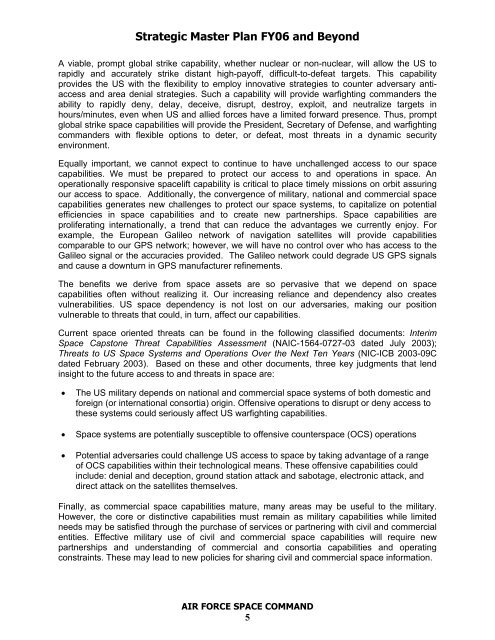STRATEGIC MASTER PLAN FY06 and Beyond - Western States ...
STRATEGIC MASTER PLAN FY06 and Beyond - Western States ...
STRATEGIC MASTER PLAN FY06 and Beyond - Western States ...
You also want an ePaper? Increase the reach of your titles
YUMPU automatically turns print PDFs into web optimized ePapers that Google loves.
Strategic Master Plan <strong>FY06</strong> <strong>and</strong> <strong>Beyond</strong><br />
A viable, prompt global strike capability, whether nuclear or non-nuclear, will allow the US to<br />
rapidly <strong>and</strong> accurately strike distant high-payoff, difficult-to-defeat targets. This capability<br />
provides the US with the flexibility to employ innovative strategies to counter adversary antiaccess<br />
<strong>and</strong> area denial strategies. Such a capability will provide warfighting comm<strong>and</strong>ers the<br />
ability to rapidly deny, delay, deceive, disrupt, destroy, exploit, <strong>and</strong> neutralize targets in<br />
hours/minutes, even when US <strong>and</strong> allied forces have a limited forward presence. Thus, prompt<br />
global strike space capabilities will provide the President, Secretary of Defense, <strong>and</strong> warfighting<br />
comm<strong>and</strong>ers with flexible options to deter, or defeat, most threats in a dynamic security<br />
environment.<br />
Equally important, we cannot expect to continue to have unchallenged access to our space<br />
capabilities. We must be prepared to protect our access to <strong>and</strong> operations in space. An<br />
operationally responsive spacelift capability is critical to place timely missions on orbit assuring<br />
our access to space. Additionally, the convergence of military, national <strong>and</strong> commercial space<br />
capabilities generates new challenges to protect our space systems, to capitalize on potential<br />
efficiencies in space capabilities <strong>and</strong> to create new partnerships. Space capabilities are<br />
proliferating internationally, a trend that can reduce the advantages we currently enjoy. For<br />
example, the European Galileo network of navigation satellites will provide capabilities<br />
comparable to our GPS network; however, we will have no control over who has access to the<br />
Galileo signal or the accuracies provided. The Galileo network could degrade US GPS signals<br />
<strong>and</strong> cause a downturn in GPS manufacturer refinements.<br />
The benefits we derive from space assets are so pervasive that we depend on space<br />
capabilities often without realizing it. Our increasing reliance <strong>and</strong> dependency also creates<br />
vulnerabilities. US space dependency is not lost on our adversaries, making our position<br />
vulnerable to threats that could, in turn, affect our capabilities.<br />
Current space oriented threats can be found in the following classified documents: Interim<br />
Space Capstone Threat Capabilities Assessment (NAIC-1564-0727-03 dated July 2003);<br />
Threats to US Space Systems <strong>and</strong> Operations Over the Next Ten Years (NIC-ICB 2003-09C<br />
dated February 2003). Based on these <strong>and</strong> other documents, three key judgments that lend<br />
insight to the future access to <strong>and</strong> threats in space are:<br />
• The US military depends on national <strong>and</strong> commercial space systems of both domestic <strong>and</strong><br />
foreign (or international consortia) origin. Offensive operations to disrupt or deny access to<br />
these systems could seriously affect US warfighting capabilities.<br />
• Space systems are potentially susceptible to offensive counterspace (OCS) operations<br />
• Potential adversaries could challenge US access to space by taking advantage of a range<br />
of OCS capabilities within their technological means. These offensive capabilities could<br />
include: denial <strong>and</strong> deception, ground station attack <strong>and</strong> sabotage, electronic attack, <strong>and</strong><br />
direct attack on the satellites themselves.<br />
Finally, as commercial space capabilities mature, many areas may be useful to the military.<br />
However, the core or distinctive capabilities must remain as military capabilities while limited<br />
needs may be satisfied through the purchase of services or partnering with civil <strong>and</strong> commercial<br />
entities. Effective military use of civil <strong>and</strong> commercial space capabilities will require new<br />
partnerships <strong>and</strong> underst<strong>and</strong>ing of commercial <strong>and</strong> consortia capabilities <strong>and</strong> operating<br />
constraints. These may lead to new policies for sharing civil <strong>and</strong> commercial space information.<br />
AIR FORCE SPACE COMMAND<br />
5
















